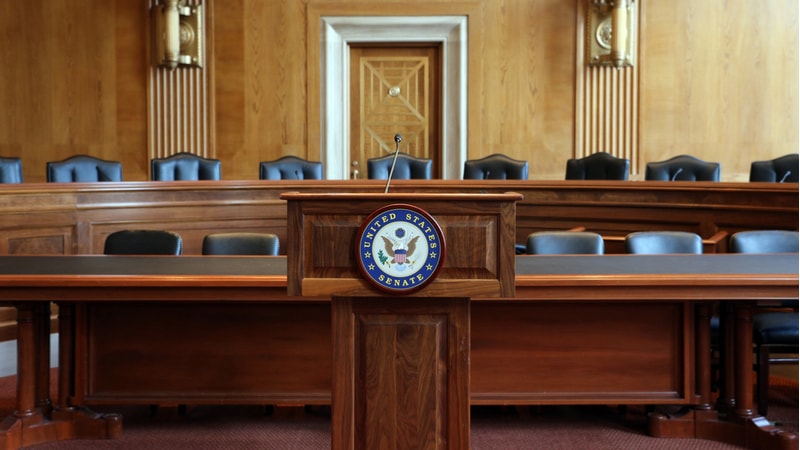
The Senate Armed Services Committee on June 23 advanced its version of the National Defense Authorization Act (NDAA) for fiscal year (FY) 2024 by a vote of 24-1.
The committee’s approval came just one day after the House Armed Services Committee advanced its version of the FY 2024 NDAA, initiating the first step in a months-long process to authorize funding and set policies for the Department of Defense (DoD).
The bill must now be debated and voted on by the full U.S. Senate.
Once the Senate and House pass their own versions of the FY 2024 NDAA, the two bills must then be reconciled into a single bill through at bicameral conference committee. Then the House and Senate will vote on the unified legislation before it goes to President Biden for his signature.
“[The NDAA] invests in the people, platforms, and programs we need to deter adversaries and safeguard the nation. This bill … addresses a broad range of pressing issues, from strategic competition with China and Russia, to disruptive technologies like hypersonics, AI, and quantum computing, to modernizing our ships, aircraft, and combat vehicles,” Sen. Jack Reed, D-R.I., chairman of the committee, said in a statement.
“My top priority is to deliver our service members the tools and capabilities they need to keep us safe. Our achievements in this year’s NDAA would advance American national defense and help take care of our service members and their families,” said Sen. Roger Wicker, R-Miss., the committee’s ranking member.
The committee and its subcommittees considered a total of 445 amendments during their markup processes, and adopted 286 amendments.
The full text of the approved Senate bill has not been released yet, but the committee did offer up an executive summary detailing several cybersecurity and technology related provisions.
Cybersecurity, Technology Provisions
On the technology front, the committee approved provisions that “emphasize the need for the DoD to adopt innovative and modern cybersecurity strategies, tools, and technologies,” according to the executive summary.
Several provisions offered during the markup reflected the need to develop strategies to help DoD respond to the cyber threat environment, and strengthen the Pentagon’s cyber posture.
Prominent among those is language in the bill proposing whether to create an independent military cyber service. The provision directs “an independent assessment of creating a Cyber Force or further evolving the existing force development and management model.”
Currently, each military service is responsible for providing personnel for a set number of teams to the U.S. Cyber Command, which then employs those forces in operations for the other geographic combatant commands.
The assessment called for the in the Senate-approved bill also would determine redundancies and duplication in how the services organize, train, and equip cyber warriors.
The bill directs the DoD to develop AI and machine learning tools to better employ narrative intelligence technology to monitor and assess information campaigns “by delivering comprehensive analysis of narrative themes, language and information patterns, and disinformation networks.”
Another provision in the Senate NDAA bill directs “a briefing on the Thunderdome Zero Trust Architecture implementation plan, including a summary, lessons learned, and plans to expand the Thunderdome prototype project.”
The Senate bill would also authorize increased funding for several initiatives related to cutting-edge technologies, including:
- the Joint All-Domain Command and Control operational experimentation testbed;
- a distributed quantum networking testbed;
- high-performance computing modernization; and
- research and development of intelligent autonomous systems for seabed warfare.
Comparison to House Bill – Pay Raise, Space Guard
The Senate NDAA bill approved June 23 both tracks with, and deviates from, some provisions in the NDAA bill passed by the House Armed Services Committee last week.
Both committees endorsed the administration’s proposed pay increase for military service members, making it highly likely that they’ll receive a 2024 increase of 5.2 percent – the largest military pay raise since 2002.
However, the measures do not include language that would grant the administration’s request for a similar pay raise for Federal civilian workers. While there is still time to add such a provision to the bill, many House Republicans are pushing for an alternative plan to make all civil servants’ pay increases “merit-based.”
Another area of commonality, both bills would create a new personnel system, unique to the U.S. Space Force – an idea that the DoD has been angling towards for the last two years. The new system would ensure that the service’s 9,400 members are part of a single structure – making the Space Force the first military service to manage all its personnel within a single component.
A recent legislative proposal, the Space Force Personnel Management Act, argues that the change would ensure that service members be “developed on an individual basis, promoted based on their competency, and move on and off sustained active service in a way that accommodates both mission requirements and personal considerations.”
Unlike the House Armed Services Committee’s version of the NDAA, the Senate bill does not include language to establish a Space National Guard, which according to the House version of the bill allows Congress to set “new personnel management benchmark by authorizing the creation of an innovative personnel management system for the Space Force.”
